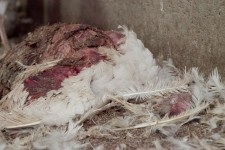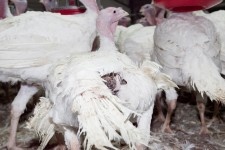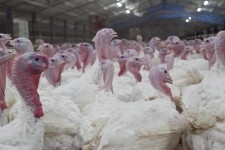- Overview
- Confinement
- Turkey poults
- Mutilation
- Artificial lighting
- Health Concerns
- Use of antibiotics
- Genetic alterations
- Muscle disorders
- Skeletal disorders
- Lame and injured birds
- Mortality rate
- Artificial insemination
- Health problems of breeders
- Slaughterhouse
- Turkeys: sentient and intelligent
- Conclusion
- References
Slaughterhouse
Another pressing welfare concern for all commercially raised turkeys is the trip to the slaughterhouse, compounded by the trauma they endure when they arrive. At the end of the growing period workers walk factory-farmed birds to the edge of the shed then herd them up a loader (conveyor belt), where workers catch the birds and pack them into crates. Thirty-two centimetres (the length of a standard ruler) is the accepted minimum height of a crate in which large birds can be transported.(84) Turkeys are much taller than 32 cm and thus are forced to travel in extremely cramped conditions.
Once the birds have been roughly and rapidly loaded into crates they are driven in a truck to the slaughterhouse. Whilst being transported turkeys are prone to injuries such as severe bruising and bleeding, amputated toes, fractures, and suffocation (due to overcrowding), as well as to high stress levels.(85) Many turkeys die before they reach the slaughterhouse and there is an 'accepted' mortality rate during transport. For example, 'dead on arrivals' is a term commonly used to describe birds who die while being transported.(86) One study found that when turkeys were monitored in various modes of transport up to 4.2% had severe damage, which included death, amputated toes, large bruises and significant bleeding, while up to 13.3% had damage of some kind, such as bruising.(87)
The same study found that 0.38% of birds died of acute and congestive heart failure, with death rates higher in summer, as many birds suffered from dehydration and metabolic problems.(88) After arriving at the slaughterhouse the birds are understandably tired, thirsty, hungry and stressed. Once inside the slaughterhouse, fully conscious birds are hung by their weak and crippled legs from metal shackles on a moving rail.(89)
The turkeys then proceed through a stunning tank where the birds' heads are put into an electrified bath of water which immobilises the birds but does not render them unconscious. Turkeys often bend their necks in order to avoid the tank and are not stunned. As turkeys are large birds their wingtips can touch the bath of water before the head, resulting in an electric shock. The Farm Animal Welfare Council, (2009) commented:
Pre-stun shocks must be painful. Wingtips hanging below the head lead to problems in waterbath stunners, particularly when larger birds like geese and turkeys are inverted.(90)
The birds' throats are then cut by a mechanical blade, and they are de-feathered in a scalding tank. The turkeys often curve their necks to avoid the blade. If the blade misses the conscious birds then proceed to the scalding tank and are boiled alive.(91) The transport and slaughterhouse procedures cause an incredible amount of stress and often a brutally slow, traumatic death for all commercially raised turkeys.




